|
|
|
Sort Order |
|
|
|
Items / Page
|
|
|
|
|
|
|
| Srl | Item |
| 1 |
ID:
169152
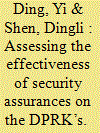

|
|
|
|
|
| Summary/Abstract |
In the Democratic People’s Republic of Korea (DPRK)’s case of nuclear
proliferation, less attention has been paid to the role of security assurances. This
paper seeks to assess the role of security assurances for the DPRK provided by the
UN, the Soviet Union, China, and the United States and to figure out why these
assurances are less effective to bridle its nuclear ambition. It argues that an effective
security assurance for nuclear non-proliferation should meet at least two conditions.
Firstly the security assurance should be credible, which can be realized by being
publicized, legally binding, and infusing with further commitments. Secondly, the
security assurance tailored to the unique features of the target state’s concerns is
more likely to be effective. Using this set of criteria, the only moderately effective
assurance is that provided by the Soviet Union. The general security assurance
of the UN is neither legally binding nor specifically targeted. The alliance with
China exists only on paper as Pyongyang believes Beijing is reluctant to fulfill its
obligation as an ally. The United States is taking a capricious attitude on the DPRK
and none of its security assurances are legalized or address its major concern of
regime survival. These may help explain why security assurances failed to prevent
the DPRK from acquiring nuclear weapons.
|
|
|
|
|
|
|
|
|
|
|
|
|
|
|
|
| 2 |
ID:
169147


|
|
|
|
|
| Summary/Abstract |
This study aims to develop a strategy for building a peace regime on the Korean
Peninsula and to explore a desirable future of the United Nations Command
(UNC) in the event that the Korean Peninsula peace treaty is signed. The study
draws lessons learned from the inter–Korean dialogues and proposes a peace
regime initiative consisting of North Korea denuclearization, transition of wartime
operational control, a security regime in Northeast Asia and a peace treaty. There is
a controversial debate regarding the dissolution or continuing presence of the UNC
after a peace treaty. This article proposes the twenty nations involved to reorganize
the UNC to consist of the UN Security Council P+5, the two Koreas, and thirteen
nations as member states of the UNC in order to play a supervisory role in a peace
treaty through the transformation of the Demilitarized Zone to a peace zone.
The article makes a policy recommendation related to the UNC Reorganization
Roadmap. The first phase is to consult with the United States on the future of the
UNC after a peace treaty in the event of substantial progress of North Korea’s
denuclearization. In addition, the ROK–U.S. should discuss and agree to the
command relations between the future Combined Forces Command and the UNC
in terms of armistice, wartime and contingency plans in the event of the transition
of wartime operational control. The second phase is to recuperate the Military
Armistice Commission (MAC), Neutral Nations Supervisory Commission (NNSC)
and consult with the United Nations Security Council (UNSC) on the reorganization
of the UNC for the Korean Peninsula peace treaty. The third phase is to reactivate
the reorganized UNC in a supervisory role for a peace treaty.
|
|
|
|
|
|
|
|
|
|
|
|
|
|
|
|
| 3 |
ID:
169153
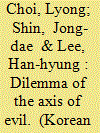

|
|
|
|
|
| Summary/Abstract |
This research examines the international relations between North Korea (the
Democratic People’s Republic of Korea or DPRK) and Iran in the context of their
shared perception of a threat from the United States. We discuss the conventional
idea of the international relationship—the enemy of my enemy is my ally—to
explain Pyongyang–Tehran relations, evaluate its past and current relations, and
offer policy suggestions for the recent denuclearization approach toward North
Korea and Iran. Using newly discovered archival resources and political records, we
challenge the conventional idea that the two states share the same threat perception
in a consistent manner and suggest the level of their military cooperation changes
depending on the approach from Washington and the international community. This
research provides a more exact picture of the international relations North Korea
and Iran since the 1980s and of the link between their shared threat perception and
denuclearization debates.
|
|
|
|
|
|
|
|
|
|
|
|
|
|
|
|
| 4 |
ID:
169148
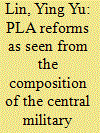

|
|
|
|
|
| Summary/Abstract |
Following the most recent round of military reforms launched in 2016, the People’s
Liberation Army (PLA), from the highest to the lowest echelons, has been moving
in the direction dictated by President Xi Jinping. The major concern of the PLA,
however, is the membership of the Central Military Commission (CMC). The
list of candidates for the CMC of the 19th National Congress of the Communist
Party of China (CPC) was not decided until the first plenary session of the Central
Committee of the CPC after the 19th National Congress. The CMC retains its one
chairman and two vice chairmen leadership structure, but only the chiefs of the
Joint Staff Department and Political Work Department, the Minister of National
Defense and the head of the Commission for Discipline Inspection are granted
a seat in the CMC. As compared with the 18th CMC, the 19th CMC has fewer
members. The decrease in the number of CMC members represents a change in
the command structure of the PLA. From a hierarchical perspective, each level of
command has its political and professional significance, also tasked with different
missions. All levels work together to manage the PLA, the world’s largest military
force. From the change in the composition of the CMC, the selection of candidates
for CMC membership, the qualifications of the candidates in terms of grade and
rank, and their functions, this study seeks to find out the impact of the 19th CMC
members and newly-appointed theater commands’ and the services’ commanding
generals and admirals on the PLA reforms as well as the implications thereof.
|
|
|
|
|
|
|
|
|
|
|
|
|
|
|
|
| 5 |
ID:
169150


|
|
|
|
|
| Summary/Abstract |
Despite 25 years of unprecedentedly friendly ties between South Korea and
China, the Terminal High Altitude Area Defense (THAAD) disputes and China’s
ensuing sanctions against South Korea have forced the bilateral relationship
into an unprecedented standoff. Given South Korea’s growing dependence on
China in economic and North Korean affairs, commentators always assumed
that the South Korean government would “manage” this relationship. China has
maintained a close relationship to keep South Korea within its orbit, restraining
Seoul from further efforts to strengthen the U.S.–South Korean alliance. However,
the Park Geun-hye government’s decision to respond to North Korea’s incessant
provocations by deploying the THAAD system in South Korea caused China to
implement economic retaliation. The ensuing paralysis of bilateral relations has
lasted for over a year. A key problem for the future of the bilateral relationship is
the fact that both countries have lost trust in each other. China views South Korea’s
decision to deploy THAAD as a betrayal of its support, while South Korea objects
to China’s relentless economic bullying. Consequently, post–THAAD South Korea–
China relations are likely to reflect South Korea’s efforts to reduce its dependency
on China and to manage its development in a more balanced way.
|
|
|
|
|
|
|
|
|
|
|
|
|
|
|
|
| 6 |
ID:
169151
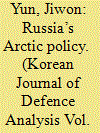

|
|
|
|
|
| Summary/Abstract |
The greatest change resulting from the Arctic thaw is the activation of Arctic
resource development and the development of Arctic ports. In this regard, Arctic
governance and Arctic regimes arising from climate change, global warming,
resource development, Arctic Route, logistics, maritime boundary delimitation,
environmental and biodiversity conservation and sustainable development are
underway, and the activities of the Arctic Council (AC). Russia is now investing
funds in a comprehensive approach to the collection of information on waterways,
hydro-meteorology and maps and the strengthening of safety measures for the
prevention of oil spills. In light of this, Russia has proceeded with long-term use
and development of the Northern Sea Route despite the constraints of the Arctic
environment and conditions. It is also calling for government cooperation with
business entities in the development of a nuclear-powered icebreaker fleet. In
particular, Russia has played the most active role in Arctic development such as
resource development and military base construction with a focus on icebreakers.
In this context, the main purpose of this article is to examine sustainable Arctic
development policies focusing on the characteristics of Arctic policies and the status
of Arctic ports and railway and road networks under Vladimir Putin’s presidency.
|
|
|
|
|
|
|
|
|
|
|
|
|
|
|
|
| 7 |
ID:
169154
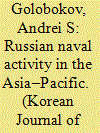

|
|
|
|
|
| Summary/Abstract |
The paper evaluates Russia’s increased naval presence in the Asian–Pacific region,
considering the naval interactions with China, India, Vietnam, the Philippines
etc., an important component of Russia’s national strategy and maritime policy
in the region. By strengthening cooperation with the navies of these countries in
different parts of the world, Moscow demonstrates its political preferences and
military capabilities by checking the combat readiness of its own Navy, as well as
modernizing its strategy and tactics, taking into account the modern experience of
combat operations among the other fleets. It then presents a valuable opportunity for
Russia to defend its national interests while remaining a non-aligned and predictable
actor. By analyzing the dynamics, metrics and substance of Russia’s naval activities,
the author tries to clarify the strategic goals of the Russian and other countries’
navies, and also to define some qualitative characteristics, such as the level of
interaction between the Russian Navy and each of its partners, operational tasks of
the exercises, etc. In addition, Russia’s joint maneuvers not only maintain its status
as a great maritime power and raises its international authority but also may serve as
a balancing factor for the U.S. and Chinese navies to improve the security situation
in the Asia–Pacific.
|
|
|
|
|
|
|
|
|
|
|
|
|
|
|
|
| 8 |
ID:
169149


|
|
|
|
|
| Summary/Abstract |
China’s North Korea policy is a combination of China’s strategic goal toward
regional order including U.S.–China relations and tactical management over North
Korea’s crisis action. Since the post–Cold War era, China has preferred the status
quo as its regional strategy, which leads them to operate tactical management
over North Korea risk. North Korea risk consists of uncertainty, which means
uncontrollability of North Korea, and instability, which means the possibility of
collapse of the North Korean regime. These risks often play as a crisis of China’s
status quo strategy, so China is inclined to implement its North Korea Policy
to control these crises. The basis of China’ North Korea policy is engagement,
considering that China has to protect North Korea’s conventional and geopolitical
values. However, the engagement comes in different forms according to the
characteristics of the crisis. The one is coercive engagement, which appears when
North Korea’s uncertainty prevails over instability. The other one is inclusive
engagement, which occurs when North Korea’s instability is stronger than
uncertainty. This hypothesis can be applied to past and current situations. With this
point of view, it is possible to predict the future of China’s North Korea policy.
|
|
|
|
|
|
|
|
|
|
|
|
|
|
|
|
|
|
|
|
|